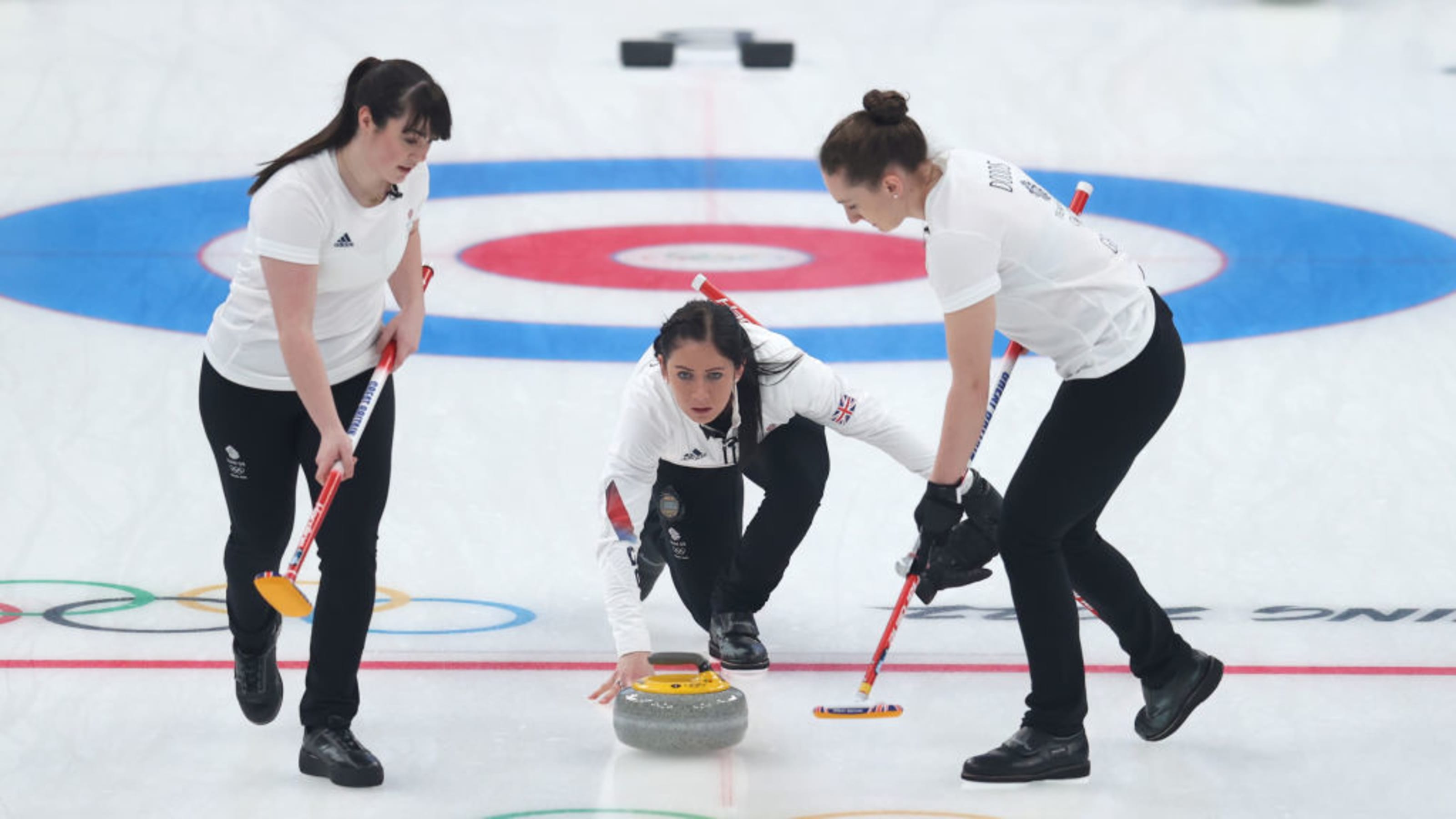
Curling (Scotland, many countries in the world)
- Name of sport (game): Curling
- Name in native language: Curling
- Place of practice (continent, state, nation):
Invented in Scotland in the 16th century it is popular in the UK (mainly Scotland) as well as countries to which Scots have exported it, including Canada, the US, New Zealand, Sweden and Switzerland. In addition curling is now played in a number of other countries, including many other areas of Europe, China, Japan and Korea.
- History:
One of the world’s oldest team sports, curling originated in the 16th century in Scotland, where games were played during winter on frozen ponds and lochs. The earliest-known curling stones came from the Scottish regions of Stirling and Perth and date from 1511. In the 1600s, stones with handles were introduced.
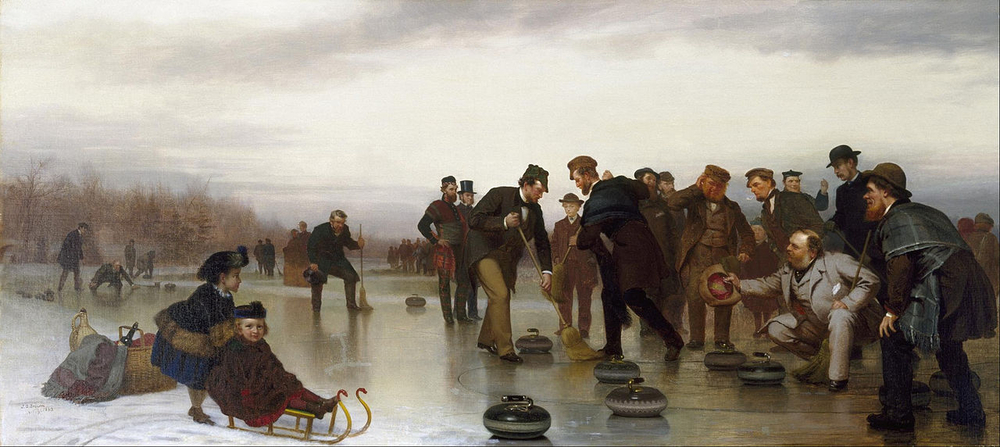 Curling; a Scottish Game at Central Park (1862) by John George Brown
Curling; a Scottish Game at Central Park (1862) by John George Brown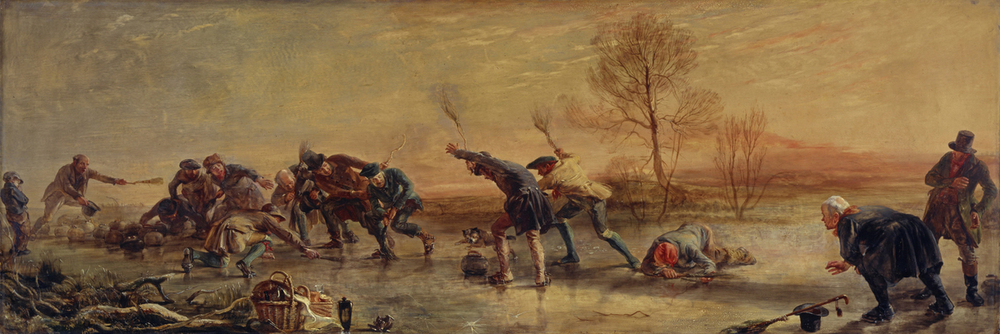 The Curlers (1835) by Sir George Harvey
The Curlers (1835) by Sir George HarveyThe first curling clubs appeared in Scotland, with the Grand Caledonian Curling Club, formed in 1838, being responsible for formulating the first official rules of the sport. The Club was renamed the Royal Caledonian Curling Club in 1843. The key 20th-century developments in the sport have been the standardisation of the stone, the development of the slide delivery, and the use of indoor, refrigerated ice facilities.
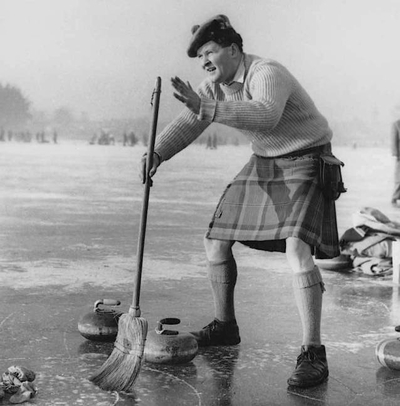
Men’s curling was included in the Olympic programme in 1924 at the first Olympic Winter Games in Chamonix. It was then dropped, and later re-introduced as a demonstration sport in 1932 in Lake Placid.
Between 1936 and 1992, curling was staged at the Games as a demonstration sport: in Garmisch-Partenkirchen in 1936 and Innsbruck in 1964, under the German name of “Eisschiessen”; and in 1988 in Calgary and in 1992 in Albertville, with both men’s and women’s events.
It was in Nagano in 1998 that it officially joined the Olympic programme, with both men’s and women’s competitions.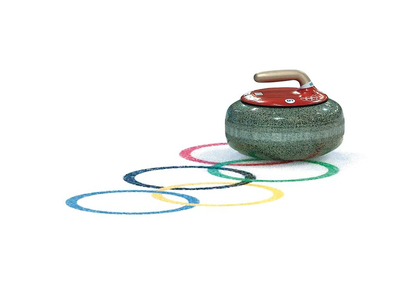
- Description:
Curling has similarities to bowls and shuffleboard (deck) and involves sliding granite stones, also called rocks, into a target area at the other end of a long, thin, strip of ice which constitutes the “pitch”. The team that propels their rocks closest to the centre of the target scores points accordingly, with the path of the stone influenced by team members who sweep and brush the ice ahead of the stone in order to alter its speed or curl.
Curling is played between two teams of four using eight granite stones each. The “pitch” is a flat, smooth area of ice measuring 45-46m long and 4.4-5m wide. There is a “house” at each end, a circular target made up of a blue outer circle with a 12ft diameter, a white circle inside that with a diameter of eight feet and a red circle with a diameter of four feet.
The stones themselves weight between 17 and 20kg, are at least 11cm high with a maximum circumference of 91cm and have a handle attached to the top. They are made of granite and the handles are usually red for one side and yellow for the other.
The two sweepers who follow the rock down the ice use brushes or brooms, usually made of fiberglass and fabric or horsehair but there are no real restrictions on the materials from which it is constructed. In addition the players wear curling shoes which are broadly similar to standard trainers except that one sole is smooth to enable sliding.
Players also usually use gloves, specific curling trousers and a stopwatch to better understand the pace of the ice and the need for sweeping.
Scoring is done after each “end” (an end being a set where both teams have thrown all eight stones) with whichever team is closest to the centre of the house being awarded a point. Further points are awarded for each stone of theirs that is closer than the best of the opposition’s. In order to score any points at least one stone must be “in the house”, which is to say touching any of the circles or overhanging them (due to the shape of the stones).
The game is won by the team that scores the most points after all the ends are complete. Most curling matches take place over ten or sometimes eight ends. If the scores are level after the allotted number of ends then an extra sudden-death end is played.
A curling sheet, with dimensions in feet (1' = 1 ft = 0.3 m). CL: Centreline • HOL: Hogline • TL: Teeline • BL: Backline • HA: Hackline with Hacks • FGZ: Free Guard Zone
Rules of Curling
Teams of four take it in turns to curl two rocks towards the target area with the scores being counted after all 16 rocks have been sent down the ice.
International matches have a time limit of 73 minutes per side with two timeouts lasting a minute each. 10 minutes and one timeout are permitted per extra end in the event of a tie.
The stone must be released its front edge crosses a line called the hog. Foul throws are removed from the ice before they have come to rest or in contact with other rocks.
Sweeping may be done by two members of the team up to the tee line, whilst after that point only one player can brush. After the tee one player from the opposing side may also sweep
A stone touched or moved when in play by a player or their broom will either be replaced or removed depending on the situation.
The team to go first is decided by coin toss, “draw-to-the-button” contest or, in Olympic competition using win-loss records. Subsequently the team that failed to score in the previous end has the advantage of going last, called the hammer throw.
A team may concede if they feel they cannot win, although depending on the event and stage of event they may have to wait until a certain number of ends have been completed.
Fair play is of huge importance so there is a culture of self-refereeing with regards fouls and this is a big part of curling.
(Source: https://www.rulesofsport.com/sports/curling.html)Equipment include:
- The curling stone (also sometimes called a rock in North America) is made of granite and is specified by the World Curling Federation, which requires a weight between 38 and 44 pounds (17.24 and 19.96 kg), a maximum circumference of 36 inches (914.4 mm) and a minimum height of 4.5 inches (114.3 mm). The only part of the stone in contact with the ice is the running surface, a narrow, flat annulus or ring, 1⁄4 to 1⁄2 inch (6.4 to 12.7 mm) wide and about 5 inches (130 mm) in diameter; the sides of the stone bulge convex down to the ring and the inside of the ring is hollowed concave to clear the ice. This concave bottom was first proposed by J. S. Russell of Toronto, Ontario, Canada sometime after 1870, and was subsequently adopted by Scottish stone manufacturer Andrew Kay.
- The curling broom, or brush, is used to sweep the ice surface in the path of the stone (see sweeping) and is also often used as a balancing aid during delivery of the stone.
- Curling shoes are similar to ordinary athletic shoes except for special soles; the slider shoe (usually known as a "slider") is designed for the sliding foot and the "gripper shoe" (usually known as a gripper) for the foot that kicks off from the hack.
- Curling pants, made to be stretchy to accommodate the curling delivery.
- A stopwatch to time the stones over a fixed distance to calculate their speed. Stopwatches can be attached either to clothing or the broom.
- Curling gloves and mittens, to keep the hands warm and improve grip on the broom.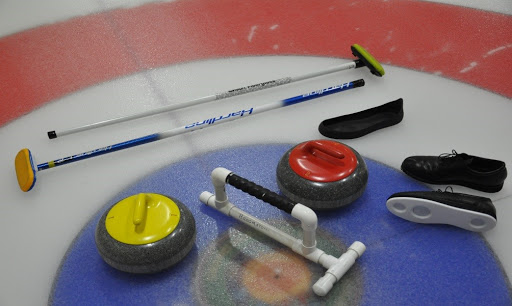
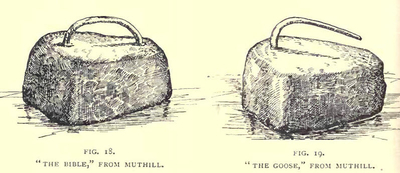
- Current status:
Practiced
The ICF was initially formed in 1966 as a committee of the Royal Caledonian Curling Club in Perth after the success of the Scotch Cup series of world championships held between Canada and Scotland. At the outset, it comprised the associations of Scotland, Canada, Sweden, Norway, Switzerland, and the United States. In the wake of its formation, it sanctioned the World Curling Championships. The WCF currently sanctions fifteen international curling events (see below). The WCF is managed by eight Board Directors, one president, three vice-presidents (one from each WCF regional zone - Americas, Europe, Pacific-Asia) and six Board Directors. The six Board Directors must all come from different member associations. All positions on the Board of Directors are elected by WCF member associations. The Board of Directors are supported by and a permanent staff of 20 employees. There are currently 61 member associations (https://worldcurling.org/member-associations/).
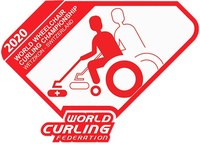
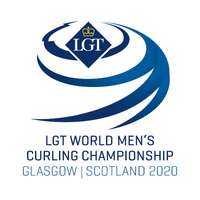
- Contacts:
World Curling Federation
Tel: +44 (0)1738 451 630
E-mail:This email address is being protected from spambots. You need JavaScript enabled to view it.
Webside: https://worldcurling.org/
Twitter: https://twitter.com/worldcurling
Instagram: https://www.instagram.com/worldcurling/
Fb: https://www.facebook.com/WorldCurlingFederation/
LinkedIn: https://www.linkedin.com/company/worldcurling/
YouTube: https://www.youtube.com/user/WorldCurlingTV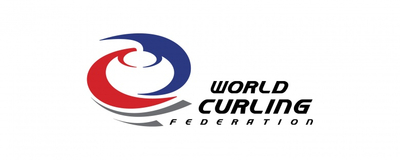
Scottish Curling
Springkerse Business Park
Stirling FK7 7XE
Tel.: +44 (0) 131 333 3003
Weside: https://www.scottishcurling.org/
Email:This email address is being protected from spambots. You need JavaScript enabled to view it.
Twitter: https://twitter.com/scottishcurling
Instagram: https://www.instagram.com/scottish_curling/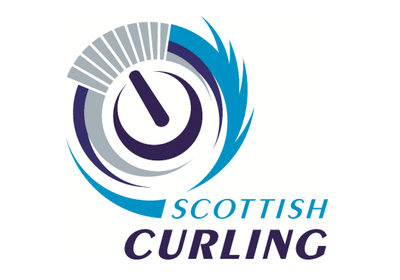
The lists of curling clubs worldwide: https://en.wikipedia.org/wiki/Lists_of_curling_clubs
List of curlers: https://en.wikipedia.org/wiki/List_of_curlers - Sources of information :
Video:
https://www.youtube.com/watch?v=wyObtpOpPkw
https://www.youtube.com/watch?v=XlifqV_0bQY
https://www.youtube.com/watch?v=TjxcZhbVSVQ&t=23s
https://www.youtube.com/watch?v=IOk9SVzqHsk
https://www.youtube.com/watch?v=6axpWJ_j850
https://www.youtube.com/watch?v=Kwz-cicOUFk
https://www.youtube.com/watch?v=ZgiG5gHiAq4
https://www.youtube.com/watch?v=KsA6grFDamo
https://www.youtube.com/watch?v=RrVgfaDPI4w
https://www.youtube.com/watch?v=TjxcZhbVSVQSource of photos used in this article and gallery:
https://olympics.com/en/news/muirhead-and-team-gb-rout-japan-for-womens-curling-gold
https://www.eurosport.com/curling/
https://www.nbcboston.com/news/sports/beijing-winter-olympics/here-are-some-fun-facts-about-the-history-of-the-sport-of-curling/2610290/
https://dcist.com/story/22/02/04/local-curling-league-winter-olympic-sport/
https://www.mmow.org/curling-a-small-beginners-guide/
https://electricscotland.com/history/curling/chapter2.htm
https://www.thetimes.co.uk/article/old-curlers-out-in-the-cold-as-the-rules-change-sh0z2fkxqlp - Gallery:
- Documents:
 Technical_Officials_Manual_Oct_2018.pdf
Technical_Officials_Manual_Oct_2018.pdf The_Rules_of_Curling_Oct_2020.pdf
The_Rules_of_Curling_Oct_2020.pdf The_Rules_of_Curling_Showing_Changes_Oct_2020.pdf
The_Rules_of_Curling_Showing_Changes_Oct_2020.pdf Classification_Rule_V_2_-_Oct_2014.pdf
Classification_Rule_V_2_-_Oct_2014.pdf

